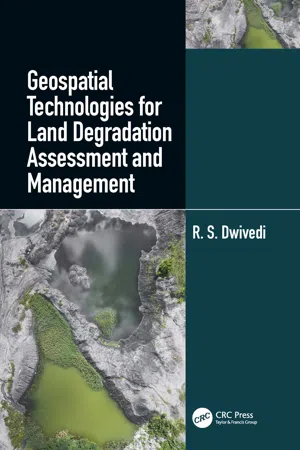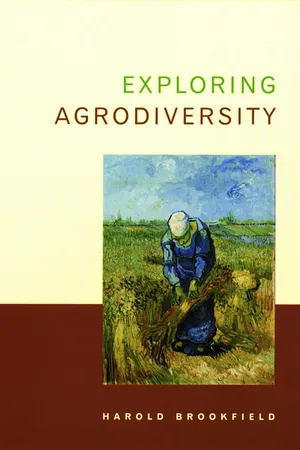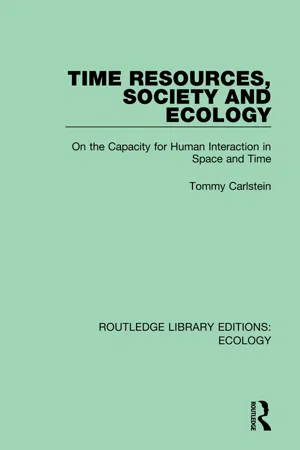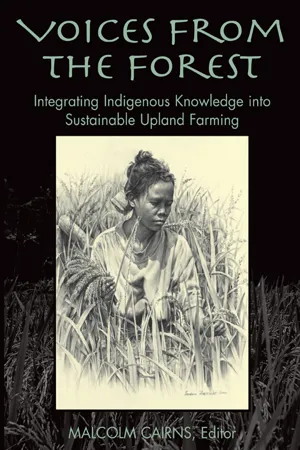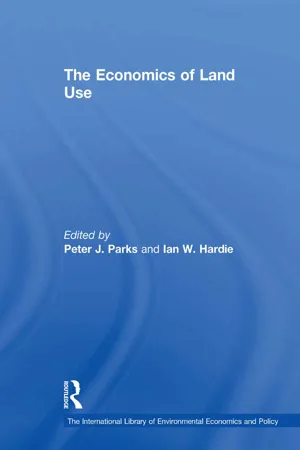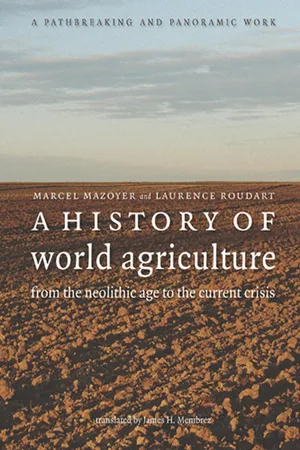Geography
Shifting Cultivation
Shifting cultivation, also known as slash-and-burn agriculture, is a traditional farming method where land is cleared and cultivated for a few years before being left fallow to regenerate. This practice is common in tropical regions and allows for the sustainable use of forest resources. However, it can lead to deforestation and soil degradation if not managed properly.
Written by Perlego with AI-assistance
Related key terms
Related key terms
1 of 4
Related key terms
1 of 3
8 Key excerpts on "Shifting Cultivation"
- R. S. Dwivedi(Author)
- 2018(Publication Date)
- CRC Press(Publisher)
Shifting Cultivation: Shifting Cultivation is the most complex and multifaceted form of agriculture in the world. It is highly diverse land use systems that have been evolving since as early as 10,000 BC in a wide range of distinct socioeconomic and ecological conditions, from montane to lowland ecosystems, and from tropical forests to grasslands (Spencer, 1966). Shifting Cultivation encompasses cropping systems such as horticulture and annual cropping, perennial tree crops, animal husbandry, and management of forests and fallows in sequential or rotational cycles. Shifting Cultivation is currently practiced in a wide variety forms by 500 million to 1 billion people around the world. Shifting Cultivation generally refers to any temporally and spatially cyclical agricultural system that involves clearing of land—usually with the assistance of fire—followed by phases of cultivation and fallow periods (Thrupp et al., 1997). According to Brookfield and Padoch (1994), “Shifting Cultivation is not one system but hundreds or thousands of systems.” The forms assumed by Shifting Cultivation are more varied than in practically any other land-use system (Ruthenberg, 1980). Processes of expansion and intensification in Shifting Cultivation have been widely reported for Asia (van Vliet et al., 2013) but less so for South America and especially for Amazonia (Vosti et al., 2002; Brondizio, 2009).11.2 Global Distribution
Shifting Cultivation : Shifting Cultivation, also known as swidden agriculture or slash-and-burn farming, is an age-old and prevailing subsistence farming practice in the tropical regions. There are 40–50 countries globally (Mertz, 2009) with almost 300–500 million people directly or indirectly carrying out this traditional swiddening system (Kleinman et al., 1996). Evidence from a recent meta-analysis published by van Vliet et al., (2012) suggests that these swidden cultivators are mostly located in the mountainous and hilly parts of Latin America, Central Africa, and Southeast Asia (SEA). Based on the Institute of Scientific Information (ISI) Web of Science database (October 8, 2013), swidden agriculture is mainly practiced by smallholder farmers in a conservative estimate of 64 developing countries from Africa, Latin America, and South/Southeast Asia (Figure 11.1 ).FIGURE 11.1 Spatial distribution of swidden practice (including Shifting Cultivation and slash-and-burn agriculture) in pan-tropical developing countries (Source: Adapted from Li et al. (2014)).11.3 Role of Remote Sensing
Both aerial photographs and spaceborne multispectral measurements have been utilized for assessment and monitoring of areas subject to mining, aquaculture, and Shifting Cultivation.11.3.1 Aerial Photographs
11.3.1.1 Mining
Remote sensing technique is quite useful in the detection, inventory, monitoring, and quantifying active surface mining activities or abandoned mining problems (Anderson, 1980). Aerial photographs have been used during the late seventies and early eighties for assessment and monitoring of some activities related to mining which lead to deterioration of soil health by way of developing the toxicity of certain elements. Carrel et al., (1978) used both visual interpretation and computer-aided techniques to interpret aerial photographs for monitoring reclamation activities at a strip mining site in Missouri, USA. In another study, Mroczynski and Wiesmiller (1982) used color infrared aerial photographs for evaluating reclaimed and unreclaimed land in southwestern Indiana, USA.- eBook - ePub
- Harold Brookfield(Author)
- 2001(Publication Date)
- Columbia University Press(Publisher)
DEFINING Shifting CultivationFarmers who use land rotation methods usually are described as shifting cultivators even though they may use rotation methods on only part of their land. Shifting Cultivation is very diverse, and a single descriptor is inappropriate for the great number of systems that are practiced. There are major differences between practices in a rainforest environment and in savanna, the latter placing much less reliance on fallow growth for fertility restoration and, in almost all cases, using tillage, which is of minor importance in the forests. In this chapter I concentrate on use of the forest environment, offering a fairly detailed comparison of information from within one small region of southeast Asia that has some of the most valuable literature. Before I begin, there is a problem of definition. Everyone involved with tropical agriculture knows what Shifting Cultivation is—or do they?Conklin (1957:1) proposed that Shifting Cultivation be minimally defined as any system “in which fields are cleared by firing and are cropped discontinuously (implying periods of fallowing which always average longer than periods of cropping).” Ruthenberg (1980) proposed that the term Shifting Cultivation be restricted to systems in which cultivation occupies not more than a third of total time between one cultivation and the next; where it occupies more than this, the term fallow system should be used. This proposal came late: the best regional study of Shifting Cultivation in the literature, that of Spencer (1966), included a number of systems in which cultivation occupies more of the total period of any cycle than does the fallow. Within systems commonly described as Shifting Cultivation, appropriately or otherwise, the fallow period may range from a few months to most of a human lifetime; it may be much longer than the cultivation period, about the same length, or shorter.Conklin (1957) regarded clearance by fire as a diagnostic characteristic, and the pejorative term slash-and-burn cultivation requires it. This creates further problems. Use of fire in fallow-based systems ranges from burning for total clearance, through patch burning and burning only of debris, to the complete absence of fire. There are some very “shifting” systems in which crops are planted in the mulch, without any burning. Trees may even be felled only after the crops are in the ground (Schiefflin 1975; Orejuela 1992; Thurston et al. 1994). At the other end of the scale, controlled use of slashing and burning forms part of some of the world’s most permanent and intensive farming systems (Michon and Mary 1994). The term slash-and-burn cultivation obscures even more than does Shifting Cultivation - eBook - ePub
Time Resources, Society and Ecology
On the Capacity for Human Interaction in Space and Time
- Tommy Carlstein(Author)
- 2019(Publication Date)
- Routledge(Publisher)
Shifting Cultivation itself gives a hint of spatio-temporal structure and variability. As with food collectors, shifting cultivators must be mobile in space and time, but with different frequencies, durations and relative locations. Not only are individuals mobile but the settlement system itself undergoes spatial changes and shifts which reflect on society and habitat. Some of the previously outlined mechanisms are found also with shifting cultivators but in new combinations and with different magnitudes and significance. When stationary plants are cultivated, land (space-time) requirements also become more obvious perhaps and the cultural landscape more visible. In this context, carrying capacity and packing problems in a settlement space-time budget are more easily represented, although they are crucial in all systems and ecotechnologies.Conklin (1961) gives the following minimum definition for shifting or swidden cultivation: ‘any continuing agricultural system in which impermanent clearings are cropped for shorter periods in years than they are fallowed’. Pelzer (1945) has given a more inclusive definition by listing the following characteristics:- 1) rotation of fields rather than crops,
- 2) clearing by means of fire,
- 3) absence of draught animals and of manuring,
- 4) use of human labour only,
- 5) employment of dibble-stick or hoe, and
- 6) shorter periods of soil occupancy altering with long fallow periods.
Shifting agriculture has several names such as swidden, slash-andbum, field-forest rotation, and cut-and-bum agriculture. The term swidden was introduced by Izikowitz (1957:7) using an obsolete English word and it has since become widely used. It illustrates the most marked feature of this cultivation system: the use of fire as a tool for clearing and as a method of fertilization. The term ‘shifting’ emphasizes the space-time feature of relative impermanence of land occupation. It may sound objectionable to some to call this type of cultivation system ‘agriculture’ instead of horticulture or gardening, since ‘agri’-culture is generally associated with permanent fields under plough tillage. All the same, at the general level of analysis employed here, this distinction will be dropped. - eBook - ePub
Indigenous Agricultural Revolution
Ecology and Food Production in West Africa
- Paul Richards(Author)
- 2023(Publication Date)
- Routledge(Publisher)
There are important differences in the way Shifting Cultivation is carried out in forest and savanna environments. In the forest zone the cultivation-fallow cycle is generally short: typically, 1-4 years of cultivation followed by 5-15 years of fallow. In the savanna, cultivation for several years – between 2 and 10, depending on the quality of the soil – will generally be followed by a long fallow interval (perhaps 20 or 30 years in districts where land is abundant), since grassy fallows regain fertility much more slowly than woody fallows. The biomass of a newly cleared forest plot is perhaps 4-5 times that of a savanna plot, so that burning of vegetation is of correspondingly greater significance in forest areas, both for clearing felled vegetation and as a means of liberating plant nutrients. Many savannas are burnt annually, but either by accident or by pastoralists seeking a flush of new grass towards the end of the dry season. Once a plot is abandoned to fallow it may be left for up to a generation or more.Few if any West African farmers rely solely on Shifting Cultivation. Most commonly, a shifting cultivated ‘upland’ is combined with some element of valley-bottom ‘wet-land’ cultivation, or a shifting cultivated ‘outfield’ is combined with a permanently cultivated, manured and composted ‘infield’ plot. In some areas, e.g. around some of the larger cities in the savanna, or in densely populated tree-crop farming districts, the Shifting Cultivation element is of minor proportions or has disappeared entirely (Hill, 1977 ; Lagemann, 1977 ; Mortimore, 1971 ; Ruthenberg, 1980 ). Nevertheless, I shall argue that the ecological knowledge associated with Shifting Cultivation continues to provide an important part of the conceptual framework within which West African farmers approach their problems, and for this reason must be understood by agencies contemplating ‘populist’ strategies of agrarian change.Two viewpoints have dominated the literature on Shifting Cultivation: the ‘systems’ approach and the ‘stage’ approach.The systems approach
This approach assumes that Shifting Cultivation is an integrated set of practices constituting a distinct type of farming enterprise, i.e. a ‘farming system’.Early attitudes to Shifting Cultivation as a system were almost entirely negative. It was a bad system: exploitative, untidy and misguided. The Parliamentary Under-Secretary of State for the Colonies, W.G.A. Ormsby-Gore, summed up the attitude of the day when noting that in Sierra Leone, for example, ‘the natural forest has been ruthlessly destroyed to find virgin soil for the cultivation of “hill” or “land” rice.’ (Ormsby-Gore, 1926 - eBook - ePub
Voices from the Forest
Integrating Indigenous Knowledge into Sustainable Upland Farming
- Malcolm Cairns, Malcolm Cairns(Authors)
- 2010(Publication Date)
- Routledge(Publisher)
The transfer of land ownership from local communities to the state also brought negative impacts to land management because the government was incapable of extending its management down to the lowest administrative levels in rural areas. Illegal selling of land by tribal cultivators to Viet (lowland) immigrants contributed to the scarcity of agricultural land and accelerated encroachment into forests. At the same time, agroindustry, and its demands for both markets and land, brought a major influence to the livelihoods of minority ethnic groups.An Economic, Social, and Environmental Assessment
Shifting Cultivation is characterized by its minimal inputs, usually only human labor. No complicated tools, draft animals, irrigation, or fertilizers are used. Its low demands for investment make it suitable to resource-poor ethnic minorities. In terms of output, crop yields can only marginally meet the food needs of swidden populations and there is almost no surplus for marketing. Shifting Cultivation, therefore, is subsistence oriented and its practitioners often lack the resources to meet other basic needs.Shifting Cultivation not only generates low income, but also appears to be economically ineffective compared to alternative land uses. If, for instance, shifting cultivators converted their efforts to management and harvest of forest products, they would realize a far greater benefit. The growth rate of evergreen forest in the central highlands is very high and can reach volumes up to 300 m3 /ha/year. The potential value of forest products is two to three times that of the products from Shifting Cultivation.Because the land available for Shifting Cultivation is decreasing rapidly and crop yields within these degrading systems are themselves declining, traditional farming methods can no longer meet the food demands of the population, to say nothing of their other basic needs. Most farmers who rely heavily on Shifting Cultivation live far below the poverty line. According to criteria set by the Ministry of Labor, War Invalids, and Social Affairs, a “starving household” is defined as earning a per capita income equivalent to less than 8 kg of rice per month. A “poor household,” on the other hand, earns less than 15 kg of rice per month. In Shifting Cultivation communities, none of the households has sufficient food. Sixty percent of them fall into the “starving” category and the remaining 40% are regarded as “poor.” - eBook - ePub
- Ian W. Hardie, Peter J. Parks(Authors)
- 2017(Publication Date)
- Routledge(Publisher)
table 1 ). Grigg (1985, page 99) cites as much as one third of the world’s arable land in Shifting Cultivation as late as the 1970s. Many tropical soils are ancient and plant nutrients have been removed by leaching. Under intense agriculture, these soil types rapidly lose fertility (Fearnside, 1979; 1980; Sanchez et al, 1982). Eight months after establishing a cleared plot, symptoms of nitrogen and potassium deficiency begin to appear (Sanchez, 1979). Soil compaction reduces water penetration and encourages erosion (Gradwohl and Greenberg, 1988). The traditional response to these problems is to burn a small plot of forest, releasing nutrients and organics into the soil. The soil pH is raised, making nutrients more available (Hecht, 1985). But within a short period, the nutrients are depleted and soil acidity returns (Sanchez, 1979). Within a few growing seasons, productivity drops significantly (Herrera et al, 1981). At the same time, natural revegetation is rapid in the tropics. Indeed, the invasion of ‘weeds’ is often the motive for abandoning a field after a few years (Smith, 1978; Wilkins, 1991). This rapid revegetation has been documented in Brazil (Lynn Smith, 1972), and Peru (Sanchez and Nurena, 1972; Scott, 1974) in the `New World’, and in Sri Lanka (Joachim and Kandiah, 1948), Mindanao (Kellman, 1969), and New Guinea (Clarke, 1967) in the `Old World’ tropics. Native populations have used this approach for millennia (Reid, 1989). On the basis of this native experience, fallow agriculture is often recommended as an optimal strategy today (Gradwohl and Greenberg, 1988; Smith, 1982). The combination of poor soils and rapid revegetation makes fallow cultivation a useful strategy.Shifting Cultivation often is associated with time-bound, traditional practices, but changes in rotational practices throughout the developing world during the past two generations have suggested that shifting agriculturalists respond relatively quickly to economic and environmental changes. Grigg (1985, pages 98 – 99, 108, 142 – 147) notes the responsiveness of the length of fallow period to increasing population pressure around the Third World. Sometimes cultivators’ responses are based in an accurate, if intuitive, understanding of the social and natural relationships involved, particularly when the events remain within the sample space of their experiences. In other cases, involving more rapid and drastic environmental change, responses have not always been as fortuitous. In eastern Amazonia, colonization plans called for small holdings that permitted a family to use 8 ha fields for two years, followed by ten years of fallow (Smith, 1982). However, economic assessment suggested that corporate cattle ranching would be a more profitable use of the land (Hecht et al, 1988). Expected profits were greatest with grazing on unimproved soils. The result was extensive conversion of small, 75 ha farms into ranches with an average size of 620 ha (IBGE, 1987). The conversion resulted in deforestation, soil degradation, and erosion (Hecht et al, 1988). - eBook - ePub
A History of World Agriculture
From the Neolithic Age to the Current Crisis
- Marcel Mazoyer, Laurence Roudart(Authors)
- 2006(Publication Date)
- Monthly Review Press(Publisher)
3Systems of Slash-and-Burn Agriculture in Forest Environments:
Deforestation and the Formation of Post-Forest Agrarian Systems
Humanity, disdainful of what was created without it, believes ... that it can develop [the planet] by destroying the slow accumulation of plant wealth that collaboration between the atmosphere and the earth had produced over thousands of centuries. Will the large ... tropical ... forest, this huge laboratory of climates, this humid and warm velvet belt of plants from which rhythmic spirals of atmospheric waves harmoniously soar, be transformed wisely, exploited with respect for humanity and nature, by taking into account its relationship with the soil and the atmosphere, or will humanity give in to the temptation to assault the earth, attack the tropical forest quickly and without thought? In the latter case, if one thinks about it, it is humanity itself which would be endangered, ... because the atmosphere would be unbalanced and instability would be introduced into climates around the whole world.—F. SHRADER , Atlas de géographie historique , 1896Slash-and-burn agriculture is practiced in diverse wooded environments: amid mature trees, in a copse, shrubby or bushy thickets, wooded savanna, etc. It is established on terrains previously cleared by grubbing, that is, cutting followed by burning but without removing the stumps. The parcels thus cleared are only cultivated for one, two, or three years, rarely more, after which they are abandoned to return to their wooded wild state for one or more decades, before being cleared and cultivated again. Systems of slash-and-burn agriculture, also called forest agrarian systems , are thus characterized by the practice of temporary cultivation alternating with long-term wooded idling, forming a rotation with a period varying from about ten to fifty years.The origin of these systems goes back to the Neolithic epoch. From that time on, they spread to most of the forests and other cultivable wooded environments of the planet, where they lasted for thousands of years. In each region of the world, this pioneer dynamic accompanied a strong demographic growth and was pursued as long as uncleared, accessible wooded terrain remained. When all these virgin reserves were used and the population density continued to increase, the frequency and intensity of clearings increased, thus beginning a dynamic of deforestation of lands cultivated by slash-and-burn techniques. Ultimately, this resulted in the impossibility of pursuing this mode of cultivation. Deforestation generally resulted in deterioration of fertility, development of a more or less serious erosion problem, depending on the biotope, and worsening of the climate, even up to the point of desertification. - eBook - ePub
The Forest Farms of Kandy
and Other Gardens of Complete Design
- D.J. McConnell, K.A.E. Dharmapala, S.R. Attanayake(Authors)
- 2017(Publication Date)
- Routledge(Publisher)
Shifters ... and Forest Gardens as AlternativeBy selection it's possible to prove or disprove almost anything about the shifters but five propositions seem to hold their ground: Until undone by circumstance —population, commercial temptation, scowls of displeasure from their Prince - they managed to achieve a 'balanced exploitation' of their environment, to use Hans Ruthenberg's phrase. Through the millennia they modified it enormously, but what other macro-fauna hasn't? As resource managers they've been more successful than most - H. sapiens' survival proves it. On almost every count they've done less damage to the natural world in 20 000 years or so than modern agriculture has inflicted in the last 200. In economics' vision of the future, their time is running out. But there is still much to be learnedfrom the shifters.Swiddening (old English) or shifting or slash-and-burn agriculture is one of the two fountains of agriculture generally and forest gardens in particular. (The first in time was manipulation of the Great Forest - Genesis.) In both the tropics and temperate worlds, as technology, it was present at the birth of conventional field crop farming (Origins, the Flannery models). In the contemporary world it is considered wasteful, especially of tropical forests, obsolete and urgently in need of advancement to more productive systems. The thrust of this has been to move the shifters on to proper field crop farming; but it is suggested here a better alternative would be to pick up the ancient tree crops stream which was present in tropical shifting agriculture and develop that instead of the ground crops stream (Evolution, below).7.1 Shifters and the Origins
Swiddening is now confined largely to the tropics but as recently as 1920 it was still common in North Europe and existed in remote places in Finland into the 1970s. It referred to the cutting/burning of some forest patch to grow a few years of food crops until fertility was depleted, then the swidden was abandoned for a longer period for tree regrowth and fertility restoration. In Europe its origins lie far back (Parain 1942). As agriculture (wheat and barley) filtered up the river valleys from its Near East hearth it required removal of the great oak forests. One of its earliest archeological records here, c 7 000 BP, is as layers of oak charcoal and various pollens, the fingerprints of shifters. There is similar archeobotanical evidence that as agriculture moved further north to colder and less fertile sandy soils wheat and barley were replaced by rye and oats and the swidden system became more deliberative, eventually stabilizing before the 17th century as a cycle of 4-6 years of crops followed by 20-30 years of restorative birch and pine forest. From then on in Europe but less so the tropics, these two land use activities became separated - the forests managed as forests and the swiddens as permanent farms. With the trees removed as fertility source this was replaced by a grass ley phase and livestock.
Index pages curate the most relevant extracts from our library of academic textbooks. They’ve been created using an in-house natural language model (NLM), each adding context and meaning to key research topics.
Explore more topic indexes
Explore more topic indexes
1 of 6
Explore more topic indexes
1 of 4
